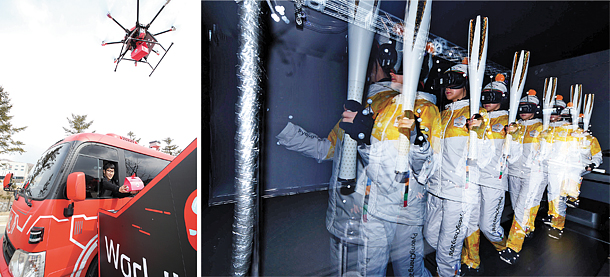5G races to PyeongChang Games

Left: A 5G-connected bus and drone during a test run for the 2018 PyeongChang Olympic Games. Right: KT staff demonstrate a virtual reality walk-through service, which allows viewers to participate in the Olympic torch relay through 5G-backed VR technology. [KT]
But instead of going to this rural resort town about 80 miles north of Seoul, where the Winter Olympics will be held next year, you’re experiencing the events from the comfort of your own home, not just on a television, but in 360-degree virtual reality.
That’s the experience that KT, the nation’s second-largest wireless carrier and official partner of the Games, wants to provide. On Tuesday, the company showcased its high-speed 5G network, an upgrade from the currently prevalent LTE network, at the Alpensia Ski Resort, where the telecom provider hopes to use the technology to live-broadcast high-speed sports like ski jumping and bobsleigh racing. The company deemed next year’s Olympics an important stepping stone for the carrier to achieve its proposed target of commercializing 5G by 2019 and being the first in the world to do so.
“KT is the only telecom company that has the chipset, device, system and service to prepare for a 5G-based Olympic Games,” said Oh Sung-mok, president of KT’s network division. “The PyeongChang Olympics will be an important milestone for KT to become a global operator.”
One example of what it wants do at the Games is to provide a virtual reality experience of events. In order to make such broadcasts possible, a high-speed network like 5G is needed to carry large amounts of data at near instantaneous speeds.
“We are in the final process of gearing up for Olympic-catered 5G services,” Oh said. “After completing the first round of pilot tests last February, we are on a successful track with our second round of tests.”
While some 5G-based services, such as those to be applied in actual sport games, need approval from international sports federations, KT has passed all tests since last month and only needs to test its Sync View services this month. Sync View will provide real-time video broadcasts from the perspective of the athlete in bobsleigh races.
Another service that has been approved is what the company calls Omnipoint View, which offers viewers full coverage of cross-country races by installing 5G-enabled cameras along the route. Viewers can use their smartphone or tablet to see course maps that display the real-time position of each athlete and videos at specific spots where cameras are installed.
An interactive Time Slice feature will allow viewers to see videos of figure skaters from various angles. For instance, when a skater jumps, viewers can quickly adjust the angle to the best view by simply moving their fingers on their phone.
“The 5G network allows larger data traffic, which enables delivery of such services to the world’s viewers, which is massive in number,” said Yoon Jong-kuk, a director at KT’s R&D Center. According to KT staff, 5G is at least 20 times faster with less delay than 4G LTE.
KT plans to finish setting up 5G network infrastructure in Pyeongchang as well as parts of Seoul by September.
BY KIM JEE-HEE [kim.jeehee@joongang.co.kr]










with the Korea JoongAng Daily
To write comments, please log in to one of the accounts.
Standards Board Policy (0/250자)